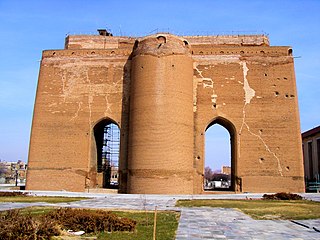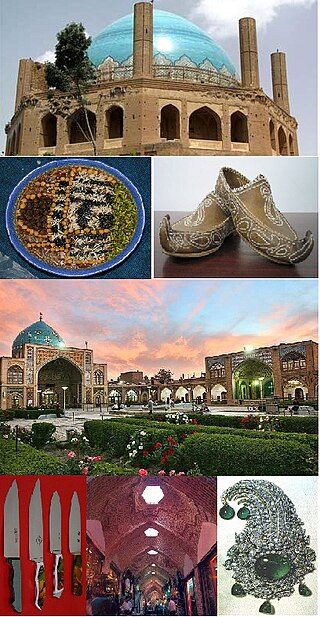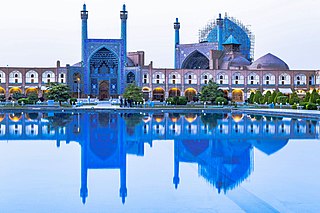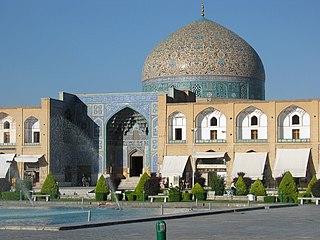
A mosque, also called masjid, is a place of prayer for Muslims. Mosques are usually covered buildings, but can be any place where prayers (sujud) are performed, including outdoor courtyards.

The Taj Mahal, is an Islamic ivory-white marble mausoleum on the right bank of the river Yamuna in the Indian city of Agra. It was commissioned in 1631 by the Mughal emperor Shah Jahan to house the tomb of his favourite wife, Mumtaz Mahal; it also houses the tomb of Shah Jahan himself. The tomb is the centrepiece of a 17-hectare (42-acre) complex, which includes a mosque and a guest house, and is set in formal gardens bounded on three sides by a crenellated wall.

Islamic architecture comprises the architectural styles of buildings associated with Islam. It encompasses both secular and religious styles from the early history of Islam to the present day. The Islamic world encompasses a wide geographic area historically ranging from western Africa and Europe to eastern Asia. Certain commonalities are shared by Islamic architectural styles across all these regions, but over time different regions developed their own styles according to local materials and techniques, local dynasties and patrons, different regional centers of artistic production, and sometimes different religious affiliations.

Razavi Khorasan Province is a province located in northeastern Iran. Mashhad is the center and capital of the province. Other cities are Bardaskan, Binalud, Chenaran, Dargaz, Fariman, Gonabad, Kalat, Kashmar, Khaf, Nishapur, Quchan, Rivash, Roshtkhar, Sabzevar, Salehabad, Sarakhs, Shahr Jadid-e Golbahar, Taybad, Torbat-e Heydarieh, and Torbat-e Jam. Razavi Khorasan is one of the three provinces that were created after the division of Khorasan province in 2004. In 2014 it was placed in Region 5 with Mashhad as the location of the region's secretariat.

The Masjid-i-Jehan-Numa, commonly known as the Jama Masjid of Delhi, is one of the largest mosques in India.

Iranian architecture or Persian architecture is the architecture of Iran and parts of the rest of West Asia, the Caucasus and Central Asia. Its history dates back to at least 5,000 BC with characteristic examples distributed over a vast area from Turkey and Iraq to Uzbekistan and Tajikistan, and from the Caucasus to Zanzibar. Persian buildings vary from peasant huts to tea houses, and garden pavilions to "some of the most majestic structures the world has ever seen". In addition to historic gates, palaces, and mosques, the rapid growth of cities such as the capital Tehran has brought about a wave of demolition and new construction.

Arg of Tabriz, is the remnants of a large acropolis fortification and city wall in downtown Tabriz, Iran. Its structure is visible from far distances in downtown Tabriz, if not blocked by the newly erected highrise buildings.

Naqsh-e Jahan Square, also known as the Shah Square prior to 1979, is a square situated at the center of Isfahan, Iran. Constructed between 1598 and 1629, it is now an important historical site, and one of UNESCO's World Heritage Sites. It is 160 metres (520 ft) wide by 560 metres (1,840 ft) long. It is also referred to as Shah Square or Imam Square. The square is surrounded by buildings from the Safavid era. The Shah Mosque is situated on the south side of this square. On the west side is the Ali Qapu Palace. Sheikh Lotf Allah Mosque is situated on the eastern side of this square and at the northern side Qeysarie Gate opens into the Isfahan Grand Bazaar. Today, Namaaz-e Jom'eh is held in the Shah Mosque.

Zanjan is a city in northwest Iran, serving as the capital of Zanjan Province. It lies 298 km (185 mi) north-west of Tehran on the main highway to Tabriz and Turkey and approximately 125 km (78 mi) from the Caspian Sea. The city is located about 20 kilometers south of the Qaflankuh Mountain Range. At the 2016 census, its population was 521,302 which is the 20th largest city in Iran. The population of Zanjan consists mostly of Iranian Azeris who are bilingual in Azerbaijani and Persian.

The Shah Mosque is a mosque located in Isfahan, Iran. It is located on the south side of Naghsh-e Jahan Square. It was built during the Safavid dynasty under the order of Shah Abbas I of Persia.

Sheikh Lotfollah Mosque is one of the masterpieces of Iranian architecture that was built during the Safavid Empire, standing on the eastern side of Naqsh-i Jahan Square, Esfahan, Iran. Construction of the mosque started in 1603 and was finished in 1619. It was built by the chief architect Mohammadreza Isfahani, during the reign of Shah Abbas I of Persia. On the advice of Arthur Upham Pope, Reza Shah Pahlavi had the mosque rebuilt and repaired in the 1920s.
Traditional Persian residential architecture is the architecture employed by builders and craftsmen in the cultural Greater Iran and the surrounding regions to construct vernacular houses. The art draws from various cultures and elements from both Islamic and pre-Islamic times.

The Sultan Ahmad 1 State Mosque is Pahang's state mosque. It is located in Kuantan, Pahang, Malaysia.

Shāh Chérāgh or Shahcheragh Shrine is the tomb of Ahmed bin Musa in the center of Shiraz. It is the third most important shrine in Shia Islam in Iran, after the Imam Reza shrine and Fatima Masumeh Shrine. Ahmed bin Musa traveled to Khorasan on the way to join his brother, but he was killed by Al-Ma'mun Abbasid Caliphate in Shiraz. Shāh-é-Chérāgh is a Persian term for "King of the Light". The site is the most important place of pilgrimage within the city of Shiraz.

Chota Imambara, also known as Imambara Hussainabad Mubarak is an imposing monument located in the city of Lucknow, Uttar Pradesh, India. It took 54 years to finalize it. Built as an imambara or a congregation hall for Shia Muslims, by Muhammad Ali Shah, the Nawab of Awadh in 1838, it was to serve as a mausoleum for himself and his mother, who is buried beside him.

The Jama Masjid of Bijapur is a congregational mosque in the Indian state of Karnataka. Initiated by Ali Adil Shah I of the Bijapur Sultanate in the 16th century, the mosque was never completed. It is the largest mosque in Bijapur, and has a capacity of 4000 worshippers.

The Imam Reza shrine in Mashhad, Iran, is a complex which contains the mausoleum of Imam Reza, the eighth Imam of Twelver Shias. It is the largest mosque in the world by area. Also contained within the complex are the Goharshad Mosque, a museum, a library, four seminaries, a cemetery, the Razavi University of Islamic Sciences, a dining hall for pilgrims, vast prayer halls, and other buildings.

Muqarnas, also known in Iranian architecture as Ahoopāy and in Iberian architecture as Mocárabe, is a form of ornamented vaulting in Islamic architecture. It is the archetypal form of Islamic architecture, integral to the vernacular of Islamic buildings that originated in the Abbasid Empire. The muqarnas structure originated from the squinch. Sometimes called "honeycomb vaulting" or "stalactite vaulting", the purpose of muqarnas is to create a smooth, decorative zone of transition in an otherwise bare, structural space. This structure gives the ability to distinguish between the main parts of a building, and serve as a transition from the walls of a room into a domed ceiling.

The Shah Mosque, also known as the Soltāni Mosque meaning "royal", renamed the Imam Mosque, after the 1979 Iranian Revolution, is a principal mosque in the northern section of the Grand Bazaar in Tehran, Iran.



















